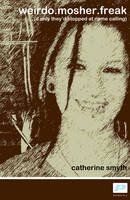
Catherine Smyth – Weirdo. Mosher. Freak. (If Only They’d Stopped At The Name Calling) The Murder Of Sophie Lancaster
Inexplicable to reasonable people but the murder of Sophie Lancaster and attack on her boyfriend Rob Maltby was in a large part driven by hate based upon dress, appearance and fear of the other. Whilst we may not want to, we all buy into stereotypes in some irrational way. It’s probably an evolutionary hangover of some kind. Like arachnophobia or fear of heights, these are responses which initially functioned to allow us to survive but which now can misfire in the context of a civilized society.
Catherine Smyth’s take in her book “wierdo. mosher. freak.” is that the attack was also down to a misguided form of jealousy fueled by drink, hormones, and bravado. I am inclined to follow her logic here when all facts as laid out in her book are taken into account and given her proximity to the case. At several other occasions in the book she demonstrates that the case isn’t quite as clear cut as the one portrayed by the national media.
It was largely the national media that plumped for the shorthand of “Goth Girl” when covering this story but as Sylvia Lancaster, Sophie’s mum, accounts in the book, she knew that Sophie was not an archetype. Rob Maltby also provides the following self portrait:
“It’s been posted around the papers that we were attacked because we were Goths but we really weren’t. The only difference was I had long hair and Sophie had dreadlocks. We were just individual, we didn’t have a name for it. ”
The attackers were described in court as feral, and that is largely true because they were certainly cut adrift parentally, drinking until the small hours among other nefarious activities. Whilst the murder fitted the M.O. of previous attacks by the15 and16 year olds who were sentenced for Sophie’s murder (and therein is a whole other law and order debate), it is never as simple as that. One other was the son of a dentist, and also an alumnus of Rob Maltby’s school, achieving 9.5 GCSEs at C or above. Another had 6 GCSEs. The assumed link between educational depravity, social disadvantage and crime looks more untenable in that light. It is this aspect that probably disturbs the most, we need our villains to be made of other stuff from us.
From her position as the first local reporter on the scene and as someone who followed the case to the extent of being directly involved in memorial activities for Sophie Lancaster, Catherine Smyth has a proximity that allows her to fill in many of the gaps in this story.
Early in the book Catherine Smyth provides some local colour from the 1970’s of Bacup, the town of the murder and also Sophie’s home town. It’s not entirely glorious. That’s not to say this is the town’s general tenor and that people can’t change, rather, Catherine’s professional instincts and independent approach won’t allow her to leave the hanging threads alone. She has to pull on them to see what’s on the other end. To go forward a couple of generations to the present, we unfortunately meet the collection of individuals who attacked Rob and Sophie producing a level of injury that the medics hadn’t seen outside of a car crash.
There are several examples in the book of kind actions from the decent people of Bacup. Rose Partridge who voluntarily tended to the floral tributes at the scene to keep them respectably tidy – an inscribed tree stands there now – is one such. Also Catherine Smyth herself; she was so affronted by the attack that she was directly involved alongside others in fund raising events for what was eventually to become the Sophie Lancaster Foundation; to the approbation of her newspaper employer. Not least of which though, in werido. mosher. freak., we have the papery evidence of how Catherine took her professional and personal concerns to a logical outcome.
The most disturbing chapter of the book for me features the emergency phone calls made by the other youths also in the park that night who bravely tried to save the pair, taking instructions, while awaiting the emergency services and who were later to become crown witnesses. It was whilst committing this harrowing transcription to paper that Catherine spotted inconstancies in the records. Later, with the permission of Sylvia Lancaster, she made formal information requests of the relevant authorities, which at the time of writing, have still not satisfactorily resolved matters. The machine of bureaucracy turns very reluctantly but Catherine Smyth will keep on tugging at that loose end.
Weirdo. Mosher. Freak. (If Only They’d Stopped At Name Calling) The Murder Of Sophie Lancaster by Catherine Smyth is available to buy now from Pomona at [link] priced at £7.99.
Profits from the book are to be split three ways – Sophie Lancaster Foundation, Author and Publishers.
